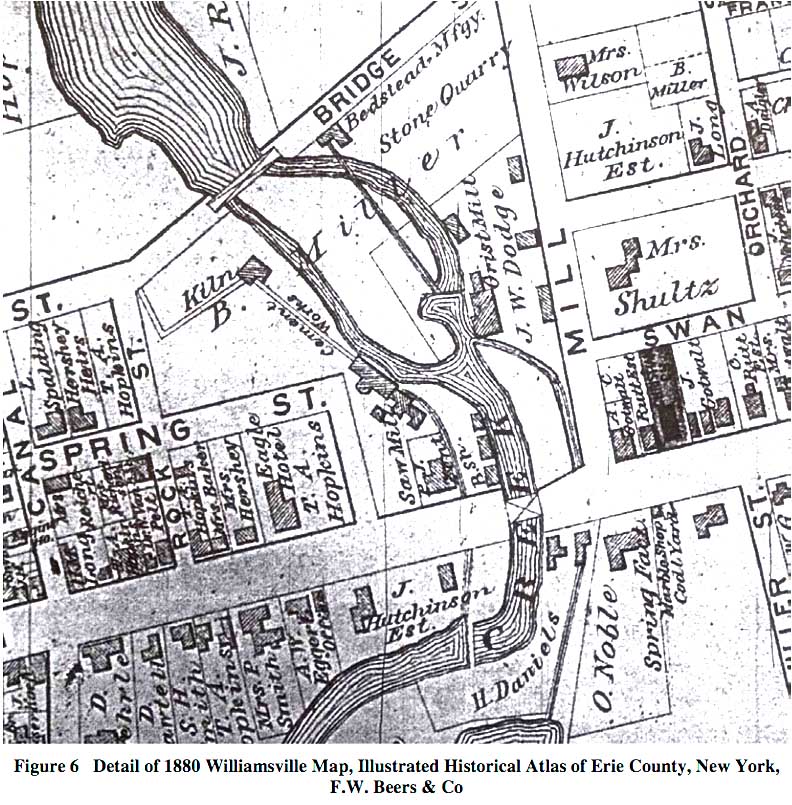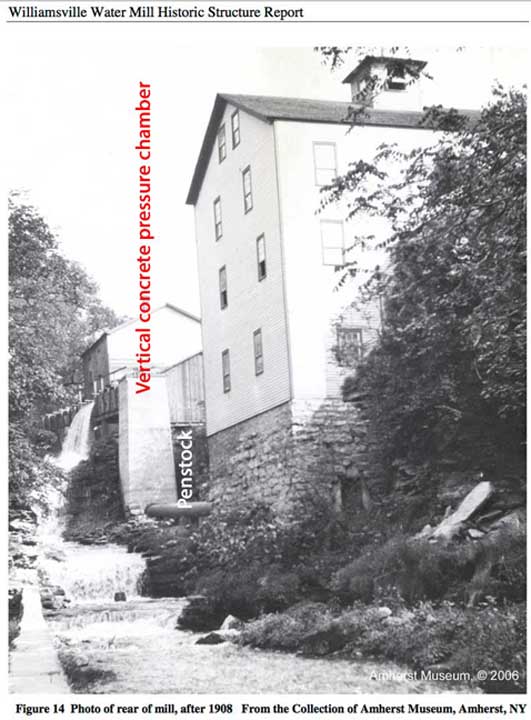Williamsville Water Mill ............................ Williamsville - Table of Contents
EXCERPTS - Historic Structure Report - Williamsville Water Mill
56 East Spring Street, Williamsville, NY
Bero Architecture P.C.
32 Winthrop Street, Rochester, NY 14607
Full Report (online October 2017)
| Pages 5-8 1799-1831 [Joseph] Ellicott identified the intersection of the Buffalo-Batavia Road with Eleven Mile Creek (now known as Ellicott Creek) as a suitable location for a settlement because of the presence of its large waterfall (now known as Glen Falls) with water volume and terrain suitable for the construction of mills. In 1799 he sold a tract of 300 acres at $2 an acre, including the falls and its milling rights, to his brother, Benjamin Ellicott, and his partner, John Thompson, both surveyors and agents of the Holland Land Company. Thompson built a sawmill on the east side of the falls, and a log house on Main Street. The sawmill venture failed within a few years, and Ellicott and Thompson sold the 300 acres in 1804 to two other surveyors, David Evans and Jonas Williams. David Evans soon tired of pioneer life and sold his share of the property to Williams, who became the main promoter of the village, which took on his name as Williams Mills. Williams repaired and operated the original sawmill on the east side of the falls [later known the Dodge Mill] until 1811, when he built an improved mill [Williamsville Water Mill] on the west side with a 12-foot overshot water wheel fed by a raceway from a stone dam built on the south side of Main Street – the same raceway which serves the mill today. Researchers differ on whether the structure built in 1811 was the present Williamsville Water Mill building, an earlier grist mill on the same site, or the sawmill structure which was located between the present Mill and the present Mill House. Our conclusion is that construction of the main block of the present mill took place between 1811 and 1828, most likely toward the end of this period. In 1814 Jonas Williams sold the mills on both sides of the creek, his water rights and his remaining property on the north side of Main Street to Juba Storrs & Co., a Buffalo merchant. Storrs owned the property until 1827. As part of the purchase arrangement, Storrs was required to make modifications to the dam to lower the level of the raceway and to create a second raceway for the east side mill; these improvements had the effect of reducing flooding on the lands still owned by Williams on the south side of Main Street. There is no evidence that the sawmill and grist mill on the west side of the creek underwent any improvements during the ownership of the Storrs company, other than the possible conversion of the grist mill into a cement mill in or after 1818, described by Warren Reist in his account of the early lime and cement business in Williamsville. Storrs made some unsuccessful speculative investments in mercantile goods and went into bankruptcy in 1820. The mill property was sold at a Sheriff’s Auction in October 1827, and again three months later. The new owner was Oziel Smith, who held the property for three years and sold the portion on the west side of the creek to Benjamin Hershey in 1830. The May 1831 transfer deed describes the property as “the grist-mill and lot on Ellicott Creek in the Village of Williamsville”; the term gristmill suggests that its conversion to a natural cement mill took place at a later date, but other documentation suggests that the cement manufacturing business may have come earlier. It is likely that the mill was able to switch between functions in response to demand. Oziel Smith 1827-1831 Oziel Smith was a well-known builder in the early history of Buffalo and Williamsville. He was the builder of the first Erie County Courthouse, built in 1810 at the present Lafayette Square, and he was active in the rebuilding of Buffalo after the War of 1812. He also had interests in the Amherst-Williamsville area, and was Amherst Town Supervisor from 1822-24. His Eagle House Tavern at 5578 Main Street opened in 1827, promptly burned down and was rebuilt, and has enjoyed an almost continuous history as a prominent local tavern. As 1827 was also the year Smith purchased the mill property there may be some connection – perhaps he bought it to help supply the lumber for the tavern, or perhaps he was looking for another project once the tavern was completed. He also may have been positioning himself to further expand the natural cement (also known as water lime) industry which had developed in Williamsville over the past few years (see section below on natural cement). The National Register nomination attributes the construction of the current mill building to 1827-28, when Smith undertook a major reorganization of the milling activities on both sides of the creek. Young, quoting the earlier local historian Harry Bigelow, describes Smith’s redevelopment as follows: “Immediately after taking possession, Esq. Smith took out all the machinery of the grist mill and replaced the granite [mill] stones with French buhr stones. He overhauled and replaced the sawmill and moved the cement business to a new building connected with the sawmill and transferred the whole water lime business to the new mill building. The making of lime continued through the summer.”The basic design was a hewn timber frame enclosing an overshot water wheel whose power was harnessed through a series of gears to operate two sets of mill stones as well as a series of elevators which raised the incoming unprocessed material to the top floor, where it passed by gravity through a series of cleaning operations before dropping onto the millstones for slow grinding. The resulting product left the millstones through grooves, dropped into a second elevator, and was raised again to the upper floors where it went through additional machinery to dry and sort it by grade. The final product then dropped into produce bins on the first floor, ready for sale or packing and shipping. |
|
Pages 13- 16 1859-1905  [Sawmill on west bank ... EdYoungs.com online October 2017]
 The next map image to describe the mill
property is the 1880 Beers' Atlas of Erie County (Fig. 6). The two parts of the mill property are labeled
“Saw Mill” and “Cement Works”.
2.6 Benjamin and Edward Miller 1866-1905 In 1866 Timothy Hopkins sold the mill property to Benjamin Miller, a local businessman with property and mercantile interests in Williamsville. Under the Miller ownership, both the natural cement business and the sawmill prospered. Natural cement was shipped throughout the Great Lakes and Erie Canal regions, but eventually its used declined due to the introduction in the U.S. of Portland cement, a similar mortar additive which was more uniform than the natural cement produced at Williamsville. |
|
Pages 17-24 1905-1919 The early years of the 20th century brought dramatic changes to the mill. In the winter of 1903 heavy ice build-up on the trestle and flume caused it to collapse into the creek bed, taking the entire sawmill with it. The flume was reconstructed to allow for continued grist milling operations, but the sawmill was never rebuilt.   [EdYoungs.com online October 2017] In 1905 Edward B. Miller died, and the property was sold to Joseph C. Jacobi, who later took on as partners Charles H. Klein and later Ferdinand Senf. A general upgrade to the property took place in the next few years, with Senf, an experienced builder, overseeing the improvements. The most substantial change was the installation of a 100 horsepower water turbine in the sub- basement to replace the water wheel. Some building improvements were made including replacement of flooring and clapboards. The section of the flume which had extended along the back of the sawmill was abandoned some time after 1910 (when it is shown in the Sanborn Map, Fig 9), and replaced by a vertical concrete pressure chamber and concrete and steel penstock. The present milling equipment, including the two sets of French buhr [mill] stones and the driving mechanism which operates them, was installed at this time. A cider press operated by a natural gas engine was installed in the north wing as part of the 1908 improvements.  [Red and white text in upper half of the photo added by editor ... Amhert Museum: Buffalo Niagara Heritage Village online October 2017] |